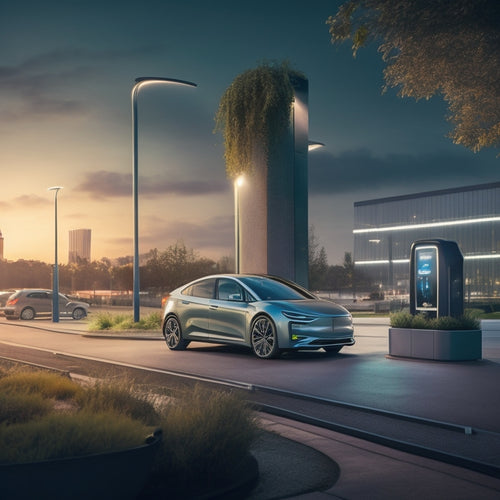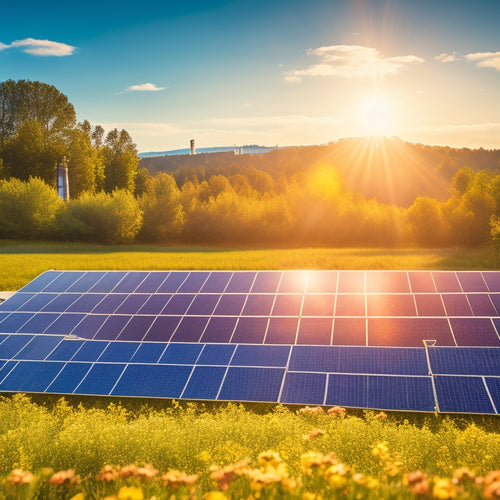
What's the Average Cost per Watt?
Share
You're likely wondering what the average cost per watt is for residential solar panel systems. Currently, it falls between $2.50 and $3.50, a vital benchmark for understanding overall installation pricing. This cost per watt affects the total expense of a solar panel system, which can range from $15,000 to $21,000 for a 5-kilowatt system. Multiple factors, including installation complexity, location, and equipment quality, influence this cost. As you investigate the world of solar panels, you'll uncover how these variables impact pricing and how understanding them can lead you to a more informed decision about your solar energy investment.
Overview
- The current average cost per watt for residential solar systems is $2.50 to $3.50.
- Commercial systems usually cost between $2.00 to $3.00 per watt, depending on the location and system size.
- The average total installation cost for a 5-kilowatt system is $15,000 to $21,000, varying based on factors like location and equipment quality.
- Variations in pricing depend on location, system size, and other factors, but the cost of solar panels has decreased significantly over the years.
- Regional pricing variations also affect the average cost per watt, with states like California and New York having higher installation costs.
Understanding Solar Panel Pricing
When sizing up a solar panel system, the sticker shock can be overwhelming, but delving into the pricing structure can help you get a better grip on the costs involved.
You'll find that solar panel types and installation costs are the primary drivers of the overall expense. Additionally, it's crucial to evaluate the cost of solar battery storage systems, which range from $5,000 to $15,000 or more solar battery costs, depending on the size and type of system needed.
By understanding the factors that influence these costs, such as system size and type, installation complexity, and upgrades to existing electrical infrastructure, you can make a more informed decision.
There are three main solar panel types: monocrystalline, polycrystalline, and thin-film. Monocrystalline panels are the most efficient but also the priciest, while thin-film panels are the least expensive but less efficient.
Installation costs, which include labor, permits, and equipment, typically range from $2,000 to $10,000. By understanding these factors, you can better traverse the pricing environment and make an informed decision about your solar panel investment.
Average Cost per Watt Today
Average Cost per Watt Today
As you investigate solar panel financing options, you're likely wondering what the average cost per watt is today. The good news is that the cost of solar panels has decreased considerably over the years.
The type and quality of equipment used in a solar panel system, such as high-efficiency inverters and deep cycle batteries, can greatly impact the overall cost System Size and Complexity.
Currently, the average cost per watt for a residential solar panel system is around $2.50 to $3.50 per watt. This translates to an average total installation cost of $15,000 to $21,000 for a typical 5-kilowatt system.
Commercial solar panel systems typically have a lower cost per watt, ranging from $2.00 to $3.00 per watt. These costs include installation, labor, and equipment expenses.
Keep in mind that these prices may vary depending on your location, system size, and other factors.
Factors Affecting Solar Panel Costs
As you evaluate the average cost per watt for your solar panel system, it's important to understand that several factors influence this cost.
You'll need to assess installation expenses, which vary depending on the complexity of the installation and local labor costs.
Streamlining installation processes can greatly reduce labor costs, which can reach up to 30% of total costs.
Additionally, optimizing system sizing and configuration through load profiling analysis can also minimize costs.
The quality of the equipment you choose will also impact the overall cost, with high-efficiency panels typically coming at a premium.
Market demand, government incentives, and financing options can also affect the final cost.
Additionally, advancements in solar technologies can drive down costs over time.
High-Efficiency Panel Premium
You'll pay a premium for high-efficiency solar panels, which can considerably impact your overall system cost.
These premium panels boast higher power output ratings, resulting in more watts per panel. This means you'll need fewer panels to achieve your desired system size, reducing installation costs and potentially increasing your energy independence.
High-efficiency technologies, such as bifacial or PERC cells, enable these premium panel benefits. While the upfront cost is higher, these panels can provide a higher return on investment through increased energy production and potentially longer lifetimes.
Assessing the premium against the benefits, you may find high-efficiency panels worth the extra cost for your solar freedom.
Budget-Friendly Solar Options Exist
Three budget-friendly solar options can greatly reduce your upfront costs: standard efficiency panels, used or refurbished panels, and thin-film panels.
These options provide affordable installations without sacrificing performance. Standard efficiency panels are a cost-effective alternative to high-efficiency panels, offering similar performance at a lower price point.
Used or refurbished panels can also provide significant savings, often with warranties still in place. Thin-film panels, made from less material, offer a more affordable option without compromising energy output.
You can further reduce costs by exploring financing options, such as solar loans or power purchase agreements.
Regional Variations in Pricing
Your budget-friendly solar option is just the starting point. As you explore the specifics, regional variations in pricing become an important factor.
You'll find that installation costs can fluctuate greatly depending on the state you're in. For instance, California and New York tend to have higher installation costs compared to states like Arizona and Texas.
These state comparisons are vital in understanding the average cost per watt. Price fluctuations can occur due to various factors, including local labor costs, permits, and incentives.
Be prepared to research and compare prices in your area to get the best deal. By doing so, you'll be well on your way to utilizing the power of solar energy and achieving the freedom you desire.
Future of Solar Panel Costs
As the solar industry continues to evolve, driving down costs is essential for widespread adoption.
You're likely wondering what the future holds for solar panel costs. The good news is that solar market trends indicate a steady decline in prices.
Technological advancements, such as more efficient panel designs and improved manufacturing processes, are driving this trend. As a result, you can expect costs to continue falling, making solar energy more accessible to individuals and businesses alike.
In fact, experts predict that the cost of solar panels will drop by as much as 50% over the next decade. This decrease will be a key factor in the widespread adoption of solar energy, ultimately leading to a cleaner, more sustainable future.
Frequently Asked Questions
How Long Does It Take to Install a Residential Solar Panel System?
You'll typically spend 1-3 days preparing for installation and 1-5 days on the actual installation, depending on the complexity of your roof and system size, with factors like permits, inspections, and weather affecting your overall installation timeline.
Can I Install Solar Panels on a Rented Property?
You'll need to negotiate a solar panel agreement with your landlord, ensuring it outlines responsibilities and benefits, as renting restrictions may apply, so it's essential to clarify the terms before installing solar panels on a rented property.
What Maintenance Is Required for Solar Panels?
Did you know that solar panels lose up to 25% efficiency when dirty? You'll need to clean your solar panels regularly to maintain peak performance. Additionally, you'll want to perform inverter maintenance every 5-10 years to guarantee maximum energy production.
Are Solar Panels Covered by Homeowners' Insurance?
You'll be relieved to know that most homeowners' insurance policies cover solar panels, providing solar panel coverage for damage or theft, allowing you to file insurance claims and rest easy knowing you're protected.
Can I Sell Excess Energy Back to the Grid?
You're thinking of breaking free from the grid, and selling excess energy back is a great start! With net metering options, you can sell energy to your utility company, offsetting your bills and gaining independence from the grid.
Ready to Buy
As you weigh your solar panel options, remember that the average cost per watt is just the tip of the iceberg. Like Achilles' heel, hidden costs and factors can leave you vulnerable to overspending. But fear not, for there are budget-friendly options and regional variations that can be your shield. And as the industry continues to evolve, the future of solar panel costs looks bright - much like the dawn of a fresh chapter, where renewable energy reigns supreme.
Related Posts
-

Solid State Batteries in Electric Vehicles
Solid-state batteries revolutionize electric vehicles by offering a longer lifespan and higher energy density than tr...
-

Advantages of Solar Generating Systems Over Traditional Energy
Solar generating systems provide several key advantages over traditional energy sources. You'll experience lower long...
-

Top 10 Off Grid Camping Gear Must-Haves
When you're off-grid camping, the right gear is crucial for a smooth expedition. Start with a durable, weather-resist...


